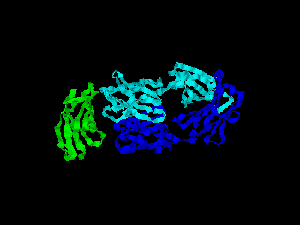Entrez 940 | Ensembl ENSG00000178562 | |
 | ||
Aliases CD28, Tp44, CD28 molecule External IDs MGI: 88327 HomoloGene: 4473 GeneCards: CD28 | ||
CD28 (Cluster of Differentiation 28) is one of the proteins expressed on T cells that provide co-stimulatory signals required for T cell activation and survival. T cell stimulation through CD28 in addition to the T-cell receptor (TCR) can provide a potent signal for the production of various interleukins (IL-6 in particular).
Contents
CD28 is the receptor for CD80 (B7.1) and CD86 (B7.2) proteins. When activated by Toll-like receptor ligands, the CD80 expression is upregulated in antigen presenting cells (APCs). The CD86 expression on antigen presenting cells is constitutive (expression is independent of environmental factors).
CD28 is the only B7 receptor constitutively expressed on naive T cells. Association of the TCR of a naive T cell with MHC:antigen complex without CD28:B7 interaction results in a T cell that is anergic.
Signaling
CD28 possesses an intracellular domain with several residues that are critical for its effective signaling. The YMNM motif beginning at tyrosine 170 in particular is critical for the recruitment of SH2-domain containing proteins, especially PI3K, Grb2 and Gads. The Y170 residue is important for the induction of Bcl-xL via mTOR and enhancement of IL-2 transcription via PKCθ, but has no effect on proliferation and results a slight reduction in IL-2 production. The N172 residue (as part of the YMNM) is important for the binding of Grb2 and Gads and seems to be able to induce IL-2 mRNA stability but not NF-κB translocation. The induction of NF-κB seems to be much more dependent on the binding of Gads to both the YMNM and the two proline-rich motifs within the molecule. However, mutation of the final amino acid of the motif, M173, which is unable to bind PI3K but is able to bind Grb2 and Gads, gives little NF-κB or IL-2, suggesting that those Grb2 and Gads are unable to compensate for the loss of PI3K. IL-2 transcription appears to have two stages; a Y170-dependent, PI3K-dependent initial phase which allows transcription and a PI3K-independent second phase which is dependent on formation of an immune synapse, which results in enhancement of IL-2 mRNA stability. Both are required for full production of IL-2.
CD28 also contains two proline-rich motifs that are able to bind SH3-containing proteins. Itk and Tec are able to bind to the N-terminal of these two motifs which immediately succeeds the Y170 YMNM; Lck binds the C-terminal. Both Itk and Lck are able to phosphorylate the tyrosine residues which then allow binding of SH2 containing proteins to CD28. Binding of Tec to CD28 enhances IL-2 production, dependent on binding of its SH3 and PH domains to CD28 and PIP3 respectively. The C-terminal proline-rich motif in CD28 is important for bringing Lck and lipid rafts into the immune synapse via filamin-A. Mutation of the two prolines within the C-terminal motif results in reduced proliferation and IL-2 production but normal induction of Bcl-xL. Phosphorylation of a tyrosine within the PYAP motif (Y191 in the mature human CD28) forms a high affinity-binding site for the SH2 domain of the src kinase Lck which in turn binds to the serine kinase PKC-θ.
Structure
The first structure of CD28 was obtained in 2005 by the T-cell biology group at the University of Oxford.
As a drug target
The drug TGN1412, which was produced by the German biotech company TeGenero and which unexpectedly caused multiple organ failure in trials, is a superagonist of CD28. Unfortunately it is often ignored that the same receptors also exist on cells other than lymphocytes. CD28 has also been found to stimulate eosinophil granulocytes where its ligation with anti-CD28 leads to the release of IL-2, IL4, IL-13 and IFN-γ.
Interactions
CD28 has been shown to interact with:
